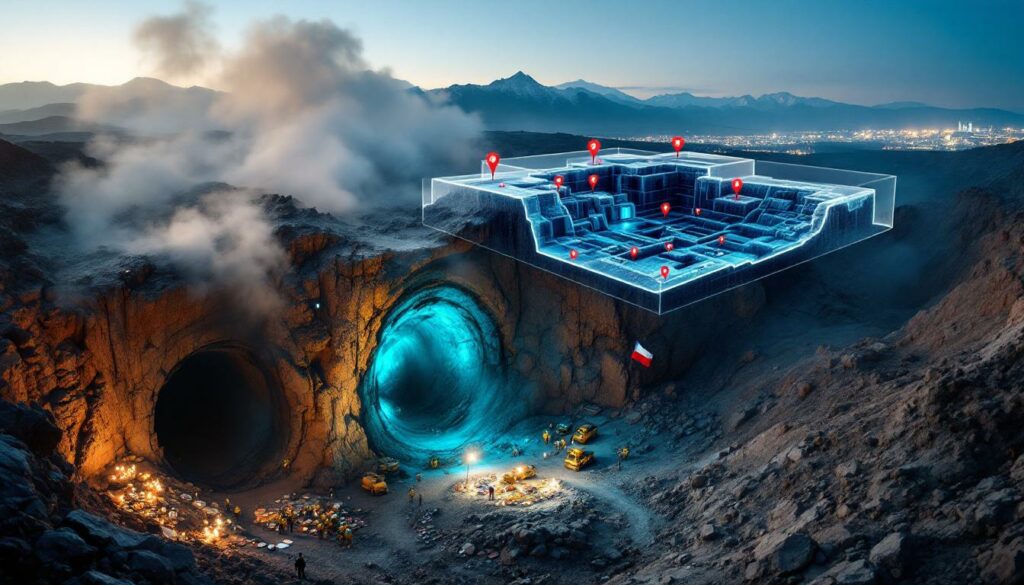The El Teniente Mine Collapse: Tragedy, Rescue, and Aftermath
On Thursday, August 1st, 2025, Chile's El Teniente copper mine experienced a devastating collapse that claimed six lives and triggered a national period of mourning. This tragedy struck at the heart of Chile's mining industry, affecting not only the families of the victims but the entire nation that depends heavily on copper production for its economic wellbeing.
What Caused the El Teniente Mine Collapse?
Seismic Activity and the 5-Magnitude Earthquake
The collapse at El Teniente was triggered by one of the largest earthquakes ever recorded at the mine site, with the impact of a 5-magnitude tremor shaking the underground tunnels. This powerful seismic event created conditions that led to the tragic collapse in the Andesita section of the mine.
According to preliminary reports, investigators are still determining whether the earthquake was purely natural or mining-induced. Chile sits along the seismically active "Ring of Fire" and regularly experiences earthquakes of various magnitudes, making it difficult to immediately ascertain the exact cause.
Key factors under investigation include:
- Whether natural tectonic activity in Chile's earthquake-prone region was solely responsible
- If mining-induced seismicity from ongoing operations contributed to the collapse
- How the combination of both factors might have affected the structural integrity of the tunnels
- Whether existing safety monitoring systems detected any warning signs before the collapse
The investigation faces considerable complexity due to the interplay between Chile's natural seismic activity and the inherent risks of underground engineering marvels.
The World's Largest Underground Copper Mine
El Teniente isn't just any mining operation—it represents one of the crown jewels in Chile's resource economy. The mine, which translates to "The Lieutenant" in English, has an illustrious history and impressive statistics that highlight its significance:
- Century-long legacy: More than 100 years of continuous operational history
- Massive copper reserves: Houses the world's largest underground copper deposit
- Extensive tunnel network: Features more than 4,500 kilometers of tunnels and underground galleries
- Significant production capacity: Produced 356,000 metric tons of copper in 2024
- Strategic location: Situated approximately 75 kilometers southeast of Santiago in the Andes Mountains
The mine's extensive tunnel network, built over generations, creates a subterranean city of sorts. This labyrinthine structure, while an engineering marvel, presents unique challenges for safety management and rescue operations when emergencies occur.
How Did the Rescue Operation Unfold?
The 70-Hour Underground Ordeal
The five miners were trapped underground for approximately 70 hours following the Thursday collapse, with hopes diminishing as rescue teams worked tirelessly to reach them. The situation was particularly challenging because:
- Rescue teams could not establish communication with the trapped workers
- The miners' locations were tracked only via GPS devices they carried
- Aftershocks continued to pose risks to both the trapped miners and rescue personnel
- Oxygen levels and structural stability remained unknown variables throughout the ordeal
The combination of these factors created a race against time as families waited anxiously for news and rescuers confronted dangerous conditions in their search efforts.
The Complex Recovery Effort
The rescue operation became one of the most technically challenging in recent Chilean mining history:
"The rescue effort began in earnest on Friday evening, once aftershocks from Thursday's tremor had subsided."
A massive team mobilized quickly to address the emergency:
- Approximately 100 rescue personnel coordinated in shifts around the clock
- Heavy machinery operated remotely to clear debris without endangering more lives
- An extraordinary 3,270 metric tons of material was carefully removed
- Rescue teams cleared 25.5 meters of passages near the El Teniente's new Andesita section
- The first worker's body was discovered on Saturday, providing grim confirmation of fears
- The remaining four workers' bodies were recovered throughout Sunday, with the final recovery at 3:30pm
The technical challenges of this operation highlighted both the dangers of underground mining and the sophisticated response capabilities that Chile has developed through years of mining safety preparation.
Who Were the Victims of the Mine Collapse?
The Six Workers Who Lost Their Lives
The human toll of this disaster stands at six miners who lost their lives in service to their country's primary industry:
- One worker died immediately during the initial collapse on Thursday
- Five additional workers were trapped underground and later found deceased after the extensive rescue operation
- President Gabriel Boric personally identified the trapped miners as Gonzalo Núñez Caroca, Álex Araya Acevedo, Carlos Arancibia Valenzuela, Jean Miranda Ibaceta, and Moisés Pavez Armijo
Each of these men represented families, communities, and the broader Chilean mining workforce that forms the backbone of the nation's economy.
Community Response and Memorials
The mining community's response demonstrated the deep connections between mining families and the importance of solidarity during tragedy:
- Dozens gathered at a makeshift memorial established outside the mine entrance
- Mourners placed candles, Chilean flags, and photos of the workers in tribute
- The final confirmation came when Moises Pavez's body was recovered at 3:30pm Sunday
- Local religious leaders held vigils and prayer services for the victims and their families
This outpouring of grief reflected how deeply mining is woven into Chile's cultural fabric and national identity.
How Has Chile Responded to the Mining Tragedy?
Three Days of National Mourning
The significance of this tragedy prompted President Gabriel Boric to declare three days of national mourning in Chile for El Teniente mine collapse from Sunday, August 3rd through Tuesday, August 5th, 2025. This official period honors the miners who lost their lives and acknowledges the collective grief felt throughout the country.
During this time, flags fly at half-mast across government buildings, and many Chileans observe moments of silence or participate in memorial activities. The national mourning period reflects how mining accidents affect the entire country, not just the immediate communities surrounding El Teniente.
Official Statements and Commitments
Government and mining officials have made public commitments to transparency, accountability, and prevention of future tragedies:
President Gabriel Boric expressed his determination in powerful terms:
"For the miners and their families: there must be justice and clarification of what happened."
Meanwhile, Codelco leadership acknowledged their responsibility to understand the disaster:
- Codelco chair Maximo Pacheco pledged to convene international experts to investigate the cause
- Pacheco stated the company would determine "what we did wrong," demonstrating accountability
- Mining Minister Aurora Williams confirmed that the labor ministry and mining regulator, Sernageomin, would evaluate when operations could safely resume
These commitments reflect the serious approach Chilean authorities are taking to prevent similar tragedies in the future.
What Is the Significance of El Teniente to Chile's Economy?
Copper Mining's National Importance
The El Teniente disaster highlights the central role mining plays in Chile's economic landscape:
- Codelco holds the position as the world's largest copper producer
- Chile supplies approximately 25% of global copper needs, earning it the nickname "the copper country"
- Copper remains essential for construction, electronics, renewable energy technologies, and countless other industries
- El Teniente serves as Codelco's flagship mine, producing 356,000 metric tons of copper in 2024 alone
This copper dependency means mining accidents have ripple effects throughout the entire Chilean economy, affecting everything from government revenues to employment rates in mining regions.
Safety Standards in Chilean Mining
Despite this tragic incident, Chile's mining industry has established strong safety standards compared to global counterparts:
- The industry is considered among the safest mining sectors globally
- Chile reported a remarkably low fatality rate of just 0.02% in 2024, according to the National Geology and Mining Service of Chile
- Rigorous safety protocols include seismic monitoring, structural reinforcement, and emergency response training
- The industry has made significant improvements since the famous 2010 San José mine rescue that captured global attention
These standards will now face intense scrutiny as investigators determine what went wrong at El Teniente despite these safety measures.
What Happens Next After the El Teniente Mine Collapse?
Investigations and Accountability
Multiple parallel investigations are now underway to determine the exact cause and prevent future disasters:
- Codelco has committed to an internal investigation involving international mining safety experts
- Government regulatory review by Sernageomin (National Geology and Mining Service) will assess compliance with safety regulations
- The labor ministry is conducting an independent assessment of working conditions and safety protocols
- Forensic teams are working to determine whether the collapse resulted primarily from natural seismic activity or mining operations
The findings from these investigations will likely lead to updated safety regulations across Chile's mining sector.
Mine Operations and Recovery
The immediate future of El Teniente remains uncertain as officials evaluate next steps:
- All operations have been suspended indefinitely since the collapse
- Comprehensive safety evaluations must be completed before any work can resume
- Engineering teams will need to develop and implement potential structural reinforcement measures
- The mining regulator will establish new safety protocols specific to seismic activity management
- Long-term impacts on copper production will depend on the duration of the shutdown
This period of assessment represents a critical juncture for both Codelco and Chile's broader mining industry evolution as they balance safety concerns with economic imperatives.
Understanding Chile's Mining Safety Challenges
Balancing Production and Protection
The El Teniente tragedy highlights the perpetual tension in mining operations between maximizing production and ensuring worker safety. Chile has made significant strides in mining safety over decades, but underground operations inherently carry risks that can never be completely eliminated.
The mining industry must continuously evaluate how to:
- Implement cutting-edge seismic monitoring technology
- Develop more responsive emergency protocols
- Create redundant safety systems that can withstand multiple failures
- Balance production pressures with conservative safety margins
- Invest in training and safety culture development
These considerations will shape how El Teniente and similar operations move forward after thorough investigations are completed.
The Human Side of Mining Disasters
Behind the statistics and technical analyses lies the profound human impact of mining disasters. The six lives lost at El Teniente represent:
- Families now facing emotional and financial hardship
- Communities that depend on mining employment feeling increased anxiety
- Colleagues who must return to similar working conditions carrying psychological trauma
- A national workforce questioning the safety of their essential industry
The psychological impact extends beyond the immediate victims to affect the approximately 40,000 workers employed by Codelco and the hundreds of thousands more in Chile's broader mining sector.
FAQs About the El Teniente Mine Collapse
How many people died in the El Teniente mine collapse?
Six people died in total—one person at the time of the collapse on Thursday and five workers who were trapped underground for 70 hours before their bodies were recovered.
What caused the mine collapse at El Teniente?
A 5-magnitude earthquake struck near the mine, one of the largest tremors ever recorded at the site. Authorities are still investigating whether the collapse was caused directly by natural seismic activity or was exacerbated by modern mine planning issues.
How long were the miners trapped underground?
The five miners were trapped underground for approximately 70 hours before their bodies were recovered during the extensive rescue operation that concluded on Sunday.
What is El Teniente's significance in global copper production?
El Teniente is the world's largest underground copper mine and part of Codelco, which is the world's biggest copper producer. Chile supplies about 25% of the world's copper, making El Teniente a crucial component of global supply chains.
How has Chile responded to this mining tragedy?
President Gabriel Boric declared three days of national mourning from August 3-5, 2025. Both the government and Codelco have committed to thorough investigations to determine the cause and prevent future accidents, with international experts being called in to assist.
As investigations conclude and the immediate crisis response ends, attention will likely turn to the mine reclamation evolution and safety improvements that must follow such a devastating event.
Disclaimer: This article contains information about an ongoing investigation into the El Teniente mine collapse. Findings, causes, and recommendations may change as more information becomes available through official investigations.
Ready to Invest in the Next Major Mineral Discovery?
Discover why significant mineral finds can generate substantial returns by exploring Discovery Alert's dedicated discoveries page, where our proprietary Discovery IQ model provides instant notifications on ASX mineral discoveries, giving you a crucial market advantage before the broader market reacts.




